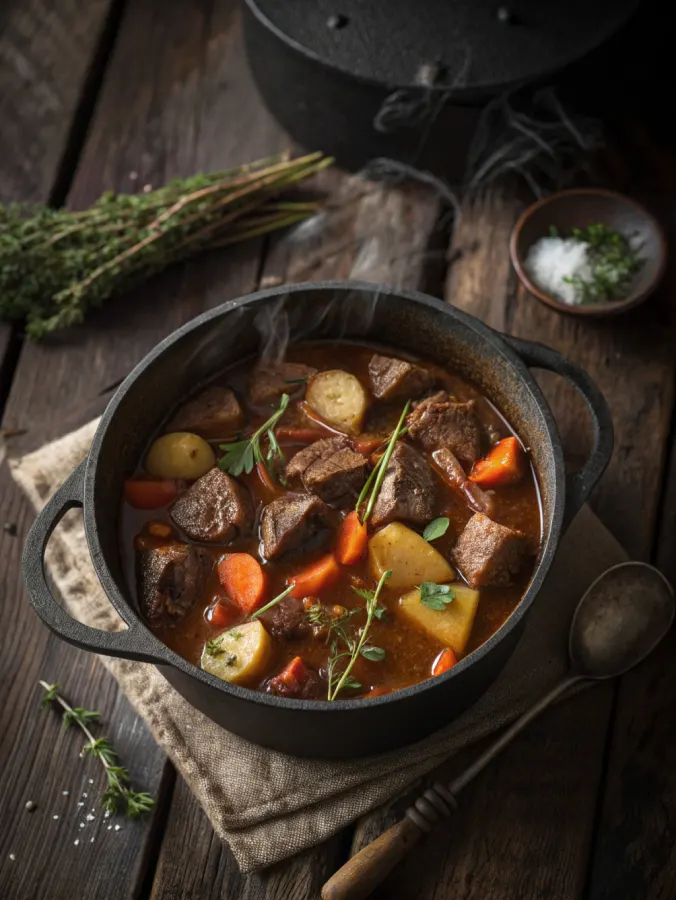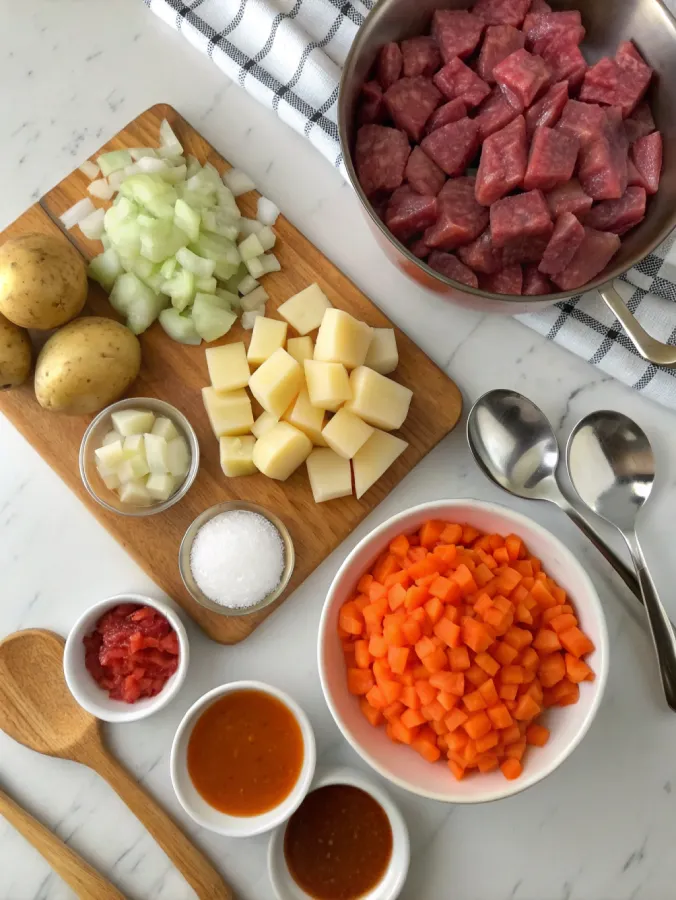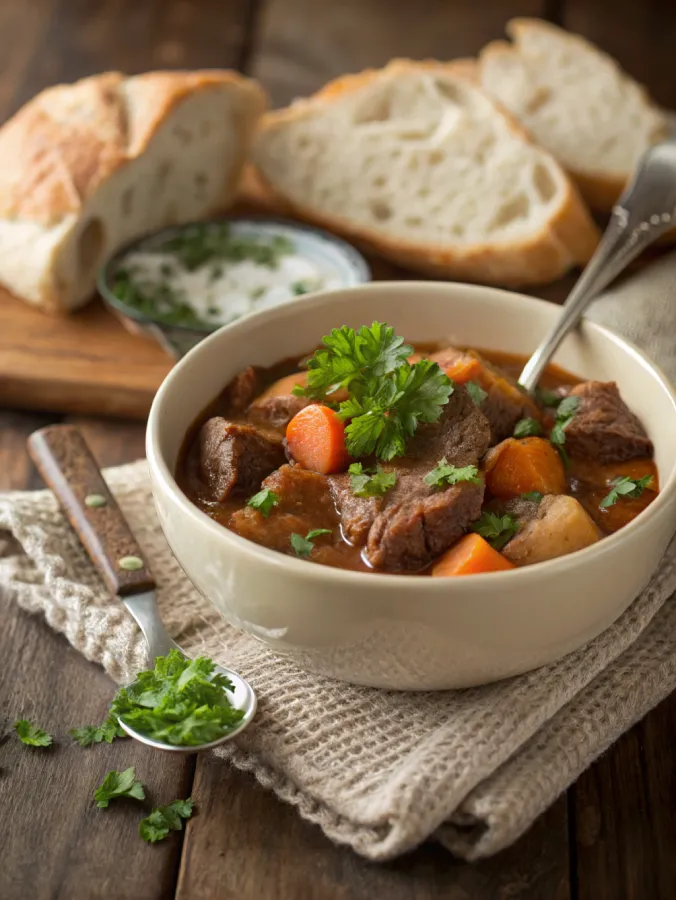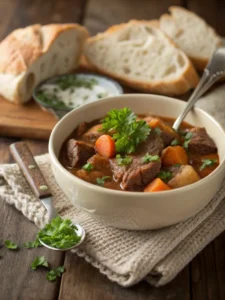
There’s nothing cozier than a pot of homemade beef stew recipe bubbling away on the stove. This recipe is a personal favorite from my kitchen here in sunny Austin, Texas. It’s hearty, rich, and packed with flavor, perfect for chilly evenings or lazy weekends. I’ve kept it approachable and flexible, whether you’re cooking for your family or just want leftovers that get even better the next day. You don’t need any fancy ingredients, just good beef, a few veggies, and a little patience. Let’s make something delicious together!
In this Article
Key Takeaways: What You Need to Know
- Use well-marbled chuck roast for tender, flavorful beef.
- Brown the meat in batches for the richest flavor.
- Simmer low and slow for perfect tenderness.
- You can thicken stew naturally with reduction or add flour or cornstarch.
- Yes, you can make it ahead, and yes, it freezes beautifully.
- Wine adds depth, but you can absolutely skip it or use broth instead.
Building Flavor from the Bottom Up
The importance of searing your beef
One of the biggest secrets to a deep, rich beef stew recipe is the browning stage. Searing beef in hot oil until a crust forms creates fond, those golden brown bits on the bottom of your pot. That fond gets deglazed and infused into your broth, adding incredible depth. Don’t rush this step. Use a heavy-bottomed pot, work in batches, and give each piece of beef space to brown, not steam. It’s worth every extra minute.
Many people skip this and toss raw beef into broth, but if you want that restaurant-level savoriness, browning is non-negotiable. I use chuck roast cut into 1½-inch cubes. It’s affordable, has just the right amount of fat, and becomes meltingly tender after a couple of hours on the stove or in a slow cooker.
While searing, don’t forget to season with salt and pepper. It helps draw out moisture and adds foundational flavor. You’ll later build on this with onions, garlic, tomato paste, and aromatic herbs like thyme and bay leaf.
You can even use the searing method in dishes like my pumpkin bread recipe, okay, just kidding, but the attention to detail is the same!
Building layers with vegetables and herbs
Once your beef is browned, it’s time for vegetables, classic stew stars like onions, carrots, and celery. I always sauté them in the same pot so they soak up the beefy goodness left behind. A tablespoon of tomato paste at this stage adds umami richness and color. Deglaze with a splash of red wine (or broth), scraping up all the delicious browned bits.
If you’re avoiding alcohol, a mixture of beef broth and a dash of balsamic vinegar is a great substitute. You’ll still get the tang and complexity that wine brings without actually using it. More on that later in our FAQs section where we explore how to make beef stew without wine.
Don’t forget to throw in aromatics, bay leaves, thyme, a garlic clove or two. These simmer slowly with the stew and bring everything together. Just like with Mediterranean diet recipes, seasoning is everything here.
Sample Ingredient List
Here’s a peek at what you’ll need. (Full recipe card is at the end!)
| Ingredient | Amount |
|---|---|
| Chuck roast, cubed | 2 lbs |
| Carrots, chopped | 3 medium |
| Celery stalks, diced | 2 |
| Yellow onion, chopped | 1 large |
| Beef broth | 4 cups |
Slow Simmering for Deep Flavor

Timing it right: How long to cook beef stew
Once your pot is loaded with seared beef, aromatic veggies, broth, and herbs, the real magic begins: slow simmering. This is where the collagen in the beef melts into gelatin, turning tough chunks into melt-in-your-mouth morsels. For the best texture and flavor, simmer your beef stew recipe low and slow for 2 to 2½ hours on the stove, or about 8 hours on low in a slow cooker.
Resist the urge to boil. High heat will toughen the beef and break down vegetables too quickly. Keep the pot partially covered, with just enough heat to see gentle bubbles. Stir occasionally to prevent sticking.
If you’re short on time, a pressure cooker can deliver tender stew in under an hour, but the depth of flavor from slow simmering is unbeatable. Like our banana bread muffins that taste better with a bit of rest, stew rewards patience too.
What vegetables work best in stew?
Classic stew vegetables aren’t just about taste, they’re about texture. Some veggies hold up to long cooking better than others. Here’s a quick breakdown:
| Vegetable | When to Add | Why It Works |
|---|---|---|
| Carrots | Early (with broth) | Sweetens as it softens |
| Potatoes | Midway | Hold shape, absorb flavor |
| Green beans or peas | Last 10 minutes | Keep color and texture |
Yukon Gold or red potatoes work beautifully in stew. Russets can turn mealy if overcooked. For added nutrients, toss in chopped kale or spinach in the final 5 minutes.
In cold months, this meal pairs beautifully with a mug of green tea or even butterfly pea flower tea for a vibrant sidekick.
When to season (and re-season)
A well-seasoned stew begins with salt on your beef, but don’t stop there. As your stew simmers, taste and adjust. Broth reduces over time, concentrating flavors, and salt. Start light and finish bold. A dash of soy sauce or Worcestershire in the final minutes adds a subtle umami boost.
Remember, your stew will taste richer the next day. So if you’re planning to serve it later, under-season just slightly. We’ll talk about reheating and storage in Part 4, but spoiler alert: beef stew is even better on day two.
Want a sweet contrast? Serve this stew with a slice of peach cobbler for the ultimate comfort combo.
Deep Flavor Without the Wine
Can you make beef stew without wine?
Yes, you definitely can, and it will still be rich, flavorful, and incredibly comforting. While traditional French beef stew often calls for red wine, it’s entirely possible to make a fantastic beef stew recipe without wine. You just need to replace the wine’s acidity and depth with smart, flavor-rich alternatives.
Instead of deglazing with wine, use beef broth, balsamic vinegar, or tomato paste and water. These ingredients lift the fond (browned bits) from the pot and create a beautifully complex base.
Here are some of the best wine substitutes for beef stew:
| Wine Substitute | Use This Amount | Flavor Profile |
|---|---|---|
| Beef broth + balsamic vinegar | 1 cup broth + 1 tbsp vinegar | Savory, tangy, umami-rich |
| Tomato paste + water | 1 tbsp paste + ½ cup water | Rich, slightly sweet and acidic |
| Soy sauce + broth | ½ tbsp soy + 1 cup broth | Deep, earthy, adds saltiness |
These swaps help replicate wine’s complexity while keeping your recipe family-friendly and alcohol-free. If you’re interested in health-conscious cooking, check out our what is the Mediterranean diet article for more ideas on flavor-rich, wholesome meals.
How to thicken beef stew naturally
A proper beef stew has a rich, silky texture that clings to your spoon. If your stew is too watery, don’t worry, there are simple, natural ways to fix that without changing the flavor.
Here are three tried-and-true methods:
- Let it reduce: Uncover the pot during the last 30 minutes of cooking to allow moisture to evaporate and flavors to concentrate.
- Use a flour or cornstarch slurry: Mix 1 tablespoon of flour or cornstarch with 2 tablespoons of cold water, then stir into the stew and simmer until thickened.
- Add instant mashed potatoes: A great gluten-free thickener that also boosts creaminess.
Each technique works depending on your dietary needs. For example, the cornstarch method is naturally gluten-free and fast. Letting it reduce is a slow but elegant option that enhances flavor as it thickens.
If you’ve ever made one of our pink salt recipes, you’ll know how small tweaks like these make a big impact in the final result.
Flavor layering: The power of finishing touches
Even if you’re skipping wine, the depth of flavor in beef stew can be elevated with a few last-minute additions. These small touches create balance and make your stew taste like it simmered all day.
Try adding any of these in the last 5–10 minutes:
- Worcestershire sauce: Deepens flavor and adds a savory kick
- A splash of balsamic vinegar: Brightens the stew without overpowering it
- Fresh herbs like parsley or thyme: Bring freshness and color
- Black pepper or crushed red pepper flakes: Add mild heat and aroma
- A spoonful of Dijon mustard: Adds subtle tang and creaminess
Taste, adjust, and don’t be afraid to customize. beef stew recipe is all about comfort, and the more it reflects your palate, the more satisfying it becomes.
Storing, Freezing & Reheating the Perfect Beef Stew Recipe
Can you make beef stew ahead of time?
Yes, and you absolutely should. In fact, the best beef stew recipe only gets better with time. When it sits overnight, the flavors meld and deepen, creating an even richer and more cohesive dish. This is the kind of meal that rewards planning ahead.
If you’re hosting or meal prepping, cook your beef stew a day in advance, let it cool, then refrigerate it in an airtight container. The next day, reheat it slowly on the stovetop over low heat until warmed through. If the stew thickens too much after chilling, just add a splash of beef broth to loosen it up.
This recipe fits perfectly into your Mediterranean diet food list if you’re focused on whole ingredients and high-nutrient comfort food, especially if you include plenty of root vegetables.
Can you freeze beef stew recipe?
Definitely. This is one of the reasons a good beef stew recipe deserves a permanent spot in your winter meal rotation. It freezes like a dream and reheats without losing flavor or texture. Here’s how to freeze it the right way:
- Cool completely before freezing.
- Transfer stew into airtight freezer-safe containers or heavy-duty freezer bags.
- Label with the date and contents.
- Freeze for up to 3 months.
To reheat, thaw overnight in the fridge, then warm gently on the stovetop. Stir occasionally and add broth if needed. The tender beef and soft vegetables hold their texture beautifully, even after freezing.
You can even freeze it in individual portions for quick lunches or dinners. Just like our banana bread recipe, this stew is a make-ahead hero that saves time and feeds you well.
Beef stew tips for best results every time
Even the simplest beef stew recipe can be elevated with a few smart tips. These strategies help you make a stew that’s not just good, it’s unforgettable.
- Use well-marbled beef like chuck roast for melt-in-your-mouth texture.
- Brown your beef in batches to lock in flavor. Don’t crowd the pan.
- Layer flavors with aromatics, tomato paste, and slow-simmering herbs.
- Taste and adjust seasoning in the final 10 minutes of cooking.
- Let it rest before serving. Even 15 minutes improves flavor and thickness.
- Don’t rush it, good stew takes time, and it’s always worth the wait.
Want more flavor? Add a spoonful of umami-rich ingredients like Worcestershire, soy sauce, or a dab of miso paste near the end. If you’re in the mood for something vibrant to pair with it, try a soothing herbal drink like butterfly pea flower tea.
What’s the best kind of beef for stew?
The foundation of any good beef stew recipe is the beef itself. And not all cuts are created equal.
The best cut for stew is chuck roast. It’s affordable, flavorful, and loaded with connective tissue that breaks down during slow cooking, creating a rich, silky texture. Other great choices include:
- Bottom round
- Brisket (for a fattier version)
- Beef shank
- Short rib meat (if you’re feeling fancy)
Avoid lean cuts like sirloin or tenderloin, they’ll dry out during long cooking. Stick to tougher, more marbled cuts that benefit from slow, moist heat. According to the USDA’s beef cuts chart, chuck is one of the most versatile and stew-friendly cuts available.
Recap: Why this beef stew recipe works every time
- Deep flavor without wine: Thanks to broth, tomato paste, and slow simmering.
- Versatile thickening options: Flour, cornstarch, or natural reduction.
- Make-ahead magic: Even better on day two, and freezer-friendly.
- Ingredient flexibility: Customize vegetables, herbs, and seasoning to suit your tastes.
- One-pot ease: Minimal cleanup, maximum comfort.
This beef stew recipe is more than a dinner, it’s the kind of meal that becomes tradition. Whether you’re batch cooking for the week or preparing Sunday dinner for your family, it delivers every time.
Want more comforting, cold-weather recipes? Explore our collection of Mediterranean diet recipes and keep your menu delicious and nourishing.

Beef Stew Recipe
Ingredients
Equipment
Method
- Pat beef dry with paper towels and season with salt and pepper.
- In a large Dutch oven, heat oil over medium-high heat and sear beef in batches until browned on all sides. Remove and set aside.
- In the same pot, add chopped onion, carrots, and celery. Cook 5–7 minutes until softened.
- Stir in minced garlic and tomato paste; cook for 1 more minute.
- Deglaze with beef broth and balsamic vinegar, scraping up any browned bits.
- Return beef to the pot. Add bay leaves and thyme. Stir to combine.
- Bring to a gentle boil, then reduce heat. Cover and simmer for 2–2½ hours, stirring occasionally.
- Optional: Mix cornstarch with water and stir in during the last 10 minutes to thicken.
- Remove bay leaves. Adjust salt and pepper to taste. Let rest for 10–15 minutes before serving.
Nutrition
Notes
Tried this recipe?
Let us know how it was!Conclusion: Why This Beef Stew Recipe Belongs in Your Rotation

There’s a reason this classic beef stew recipe remains one of the most beloved comfort food meals in American kitchens, it’s cozy, versatile, and packed with slow-cooked flavor that brings everyone to the table. Whether you’re cooking for a weeknight dinner or prepping meals for the freezer, a pot of beef stew is always a good idea.
What makes this the best beef stew recipe isn’t just the ingredients, it’s the simple but effective method: searing the beef, layering flavor with vegetables and herbs, slow simmering for tenderness, and customizing the thickness to your liking. You don’t need wine, you don’t need fancy equipment, just a solid pot and a few hours of low heat.
With this recipe, you can make hearty stew that tastes like it simmered for hours (because it did), freezes like a dream, and even gets better the next day. If you love recipes that work hard for you and warm you from the inside out, this easy beef stew recipe deserves a place in your regular rotation.
It’s comfort in a bowl, pure and simple.
For more cozy favorites and soul-warming dinners, browse through our Mediterranean diet recipes or explore the banana bread muffins that pair beautifully with a savory stew night.
Whether it’s your first time making stew or your hundredth, this is the beef stew recipe you’ll come back to again and again.
FAQ: Everything You Need to Know About Making the Best Beef Stew Recipe
Can you make beef stew ahead of time?
Yes! In fact, making your beef stew recipe a day ahead allows the flavors to deepen and develop. As it rests in the fridge overnight, the savory broth thickens, and every bite becomes more cohesive. Reheat it slowly on the stovetop, adding a splash of broth if needed to restore the perfect texture.
Making beef stew ahead is especially helpful for holidays or meal prep, giving you more flavor with less day-of cooking stress.
Can you freeze beef stew?
Absolutely. A good beef stew recipe freezes beautifully. Once cooled completely, store it in airtight containers or freezer bags for up to 3 months. Be sure to label with the date. When ready to enjoy, thaw in the fridge overnight and gently reheat on the stove. This makes beef stew one of the most practical, delicious make-ahead meals for busy weeks.
Freezing is a great way to extend the value of a large batch of beef stew, just like our other cozy staples, such as banana bread or pumpkin bread recipe, this stew proves its worth even after day one.
What are the best tips for a great beef stew?
Here are my top beef stew recipe tips that guarantee incredible results every time:
Brown the beef deeply for maximum flavor.
Use chuck roast or another well-marbled cut.
Don’t rush it, low and slow wins every time.
Add fresh herbs at the end for brightness.
Don’t skip the tomato paste, it builds umami.
Adjust thickness by simmering uncovered or adding a slurry.
These simple steps make the difference between a bland stew and one that’s worthy of second helpings. If you follow the layers of flavor in this beef stew recipe, you’ll always end up with something sensational.
What’s the best kind of beef for beef stew?
The gold standard for any beef stew recipe is chuck roast. It has the perfect balance of connective tissue and fat, which breaks down during slow cooking to create that iconic tender texture. Other great options include brisket, beef shank, and bottom round.
Avoid leaner cuts like sirloin, they may seem fancy, but they dry out quickly in stew. Stick with tougher, marbled cuts that thrive in low-and-slow cooking methods, like in this traditional, old-fashioned beef stew recipe.
According to Wikipedia, beef stew is a dish that’s beloved across cultures and continents, with each variation depending on local cuts and available ingredients.
How do you thicken stew?
A classic beef stew recipe should have a rich, spoon-coating consistency, and you’ve got options. Try these methods:
Simmer uncovered to reduce and concentrate the broth.
Use a slurry of flour or cornstarch mixed with cold water.
Stir in a spoonful of instant mashed potatoes or potato starch.
Add a flour-coated roux early in cooking for deep flavor and body.
Each method works depending on timing and texture preferences. For a naturally thick beef stew without adding starch, just give it more time, long simmering creates a naturally hearty consistency.


